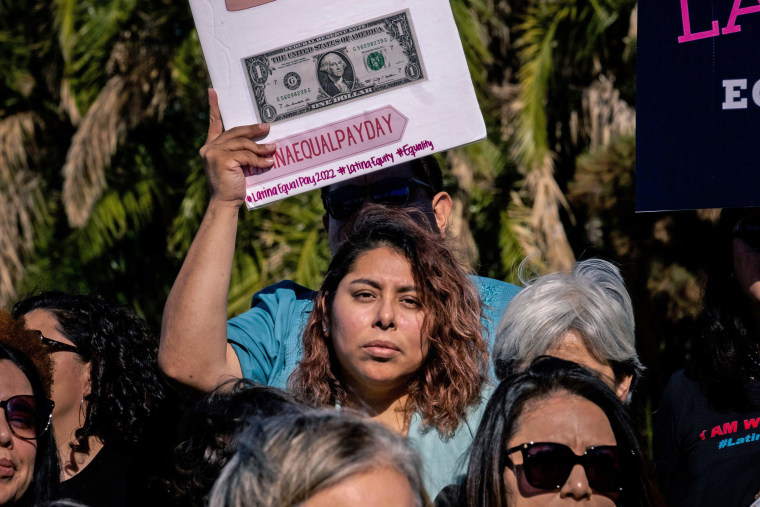Diana Ramirez is a first-generation Latina, the first in her family to go to college and the mom of two young boys. But despite getting a master’s degree in business administration and pursuing a career in policy work, Diana Ramirez said she spent 15 years not being paid equal to her white, male counterparts.
“I lost money that would have helped me save for a home, put towards my sons’ education, or pay off my steep student debt,” said the 41-year-old from El Paso, Texas.
The consequences of the cumulative pay gap for Latinas in her family are still felt today. “If my mom hadn’t faced a steep wage gap for four decades, she could have helped pay for my college expenses, which I’m struggling to pay off now,” said Diana Ramirez. “And she’d have been able to save for her own retirement. I am starting to save late in life because during those 15 years when I was underpaid, I was struggling to simply make ends meet.”

Diana Ramierez’s story mirrors that of millions of Latinas across the country. Full-time and part-time Latina workers get paid on average 52 cents for every dollar paid to non-Hispanic, white men. And for Latinas with advanced degrees like Diana Ramirez, the gender pay gap is even higher.
This year, Latina Equal Pay Day falls on Oct. 5, about two months prior to that of last year (Dec. 8).
Traditionally, the day denotes how far into the new year Latinas must work to earn as much as their white, male co-workers. But according to Monica Ramirez, the founder and CEO of Justice for Migrant Women, the new date is strategic.
“We are intentionally lifting up equal pay for Latinas as a part of Hispanic Heritage Month [which is Sept. 15 through Oct 15]. Traditionally, the Latina pay gap is observed on the day that aligns with the data, symbolizing the day that Latinas would ‘catch up’ to what white men made the year before. However, the reality is that Latinas are not catching up,” said Monica Ramirez, who is also a Latina Equal Pay Day organizer. "In addition, the Census Bureau does not release new data until September each year. This means that the most updated data becomes available too late in the year for it to inform the date that is set for Latina Equal Pay Day."
Sylvia Ann Hewlett, economist and author of “Executive Presence 2.0,” said there are several factors why the Latina pay gap is getting worse.
First, there’s the lack of executive sponsorship for Latina women. “It's very hard to convince anyone in senior ranks to advocate for them…There’s a lot of ongoing bias - the issue of accented English is huge,” said Hewlett. That bias, she noted, is even tougher to counter with the current lack of representation of Latinas in leadership roles.
Taking career breaks for childcare and caretaking responsibilities may also hinder higher pay for Latinas, according to Hewlett. “Latinas tend to have more children. They have a higher birth rate. They also have elder care issues, which are oftentimes heavier [burdens] than other ethnicities, because they don't readily put elders in assisted living. They absorb them in their household. So, a lot of them have this kind of sandwich situation,” she said.
According to new analysis by the National Women’s Law Center (NWLC), Latinas stand to lose more than $1.2 million over a 40-year career due to the wage gap—and Latinas with a professional degree stand to lose nearly $2.5 million over their career to the wage gap.
Gaylynn Burroughs, the director of workplace, equality and senior counsel for NWLC explained the grim reality behind these numbers, “[Latinas] would have to work until they’re 90 years old, which is beyond their life expectancy, to earn as much as a white, non-Hispanic male makes by the time he's 60…You really can’t catch up, because these are compounded losses.”
While the outlook for Latinas closing their own pay gap may seem far off, there are systemic changes that could help close it. Diana Ramirez, who works on policy change at NWLC, said actions like raising the minimum wage, strengthening maternity leave policies, creating union friendly policies, pay transparency and encouraging scheduling policies within organizations to allow busy mothers to plan their personal schedules ahead of time are just some changes that could make a big difference.
In the next decade Latinas are expected to grow in the workplace almost 30 percent - a higher rate than any other demographic group. They also have significant purchasing power - 85 percent of Latinas say that they are the primary decision makers in their household spending. Diana Ramirez noted, “Closing the wage gap for Latinas--and all women workers--will boost the economic security of families and strengthen our economy.”
